The retail sector has always faced security challenges, but in today's rapidly changing world, these threats are evolving at an unprecedented pace. As property managers, chief security officers, and security company hiring managers, staying ahead of these emerging threats requires proactive measures and continuous learning.
Understanding the Current Threat Landscape
Traditional vs. Modern Threats
In the past, retail security focused primarily on shoplifting and employee theft. While these remain significant issues, modern threats have become more sophisticated and varied.
Traditional Threats:
- Shoplifting
- Employee theft
- Vandalism
Modern Threats:
- Cybersecurity attacks
- Organized retail crime (ORC)
- Insider threats
- Physical violence and armed robbery
The Rise of Cybersecurity Threats
With technology integration in retail operations, cyber threats have emerged as a significant concern. Retailers now store vast amounts of customer data, making them prime targets for hackers. Common cyber threats include:
- Data Breaches: Unauthorized access to sensitive customer information.
- Phishing Attacks: Fraudulent attempts to obtain confidential information.
- Ransomware: Malicious software that locks data until a ransom is paid.
Organized Retail Crime (ORC)
ORC involves well-coordinated groups that target retail stores, often using advanced techniques to steal large quantities of goods. These groups are highly organized and can cause significant financial losses.
Insider Threats
Employees can also pose a significant security risk. Insider threats can range from theft and fraud to leaking sensitive information. Implementing robust screening processes and monitoring systems is crucial in mitigating these risks.
Proactive Measures to Enhance Security
Implementing Advanced Technology
Investing in advanced security technology can help mitigate many of the modern threats facing the retail sector. Key technologies include:
- Surveillance Systems: High-definition cameras and smart analytics to monitor and detect suspicious activity.
- Access Control: Systems to restrict and monitor entry to sensitive areas.
- Cybersecurity Measures: Firewalls, encryption, and regular security audits to protect against cyber threats.
Training and Education
Continuous training and education are vital for staying ahead of evolving threats. Security personnel should be regularly trained on the latest security protocols and threat detection techniques. This can include:
- Workshops and Seminars: Regular sessions to update staff on new threats and best practices.
- Online Courses: Flexible learning options for continuous education.
- Drills and Simulations: Practical exercises to prepare for real-world scenarios.
Collaboration and Information Sharing
Collaboration with other retailers, law enforcement, and security experts can enhance security measures. Sharing information about emerging threats and effective strategies can help create a more secure retail environment.
Risk Assessment and Management
Regular risk assessments can help identify vulnerabilities and areas for improvement. This process should include:
- Identifying Potential Threats: Understanding what threats will most likely impact your retail operation.
- Evaluating Impact: Assessing the potential impact of each threat.
- Implementing Mitigation Strategies: Developing and implementing strategies to mitigate identified risks.
Continuous Learning and Adaptation
Staying Informed
It is crucial to stay informed about the latest security trends and threats. To do so, subscribe to industry publications, attend conferences, and participate in security forums.
Adapting to New Threats
As threats evolve, so must your security measures. Review and update your security protocols regularly to ensure they are effective against current threats.
Leveraging Technology
New technologies are constantly being developed to combat emerging threats. Stay informed about the latest innovations and consider how they can be integrated into your security strategy.
FAQs
Q: What are the most common cybersecurity threats in retail?
A: Common cybersecurity threats include data breaches, phishing attacks, and ransomware.
Q: How can retailers protect against organized retail crime (ORC)?
A: Retailers can protect against ORC by implementing advanced surveillance systems, training staff to recognize suspicious activity, and collaborating with law enforcement.
Q: What is the role of employee training in retail security?
A: Employee training is crucial for keeping staff informed about the latest security protocols and threat detection techniques, which helps in mitigating both internal and external threats.
Q: How often should risk assessments be conducted?
A: Risk assessments should be conducted regularly, at least annually, or whenever there is a significant change in the retail environment.
Q: What are some effective technologies for enhancing retail security?
A: Effective technologies include high-definition surveillance systems, access control systems, and robust cybersecurity measures such as firewalls and encryption.
.png)
.png)
.png)

.png)
.png)

.png)
.png)
.png)
.png)
